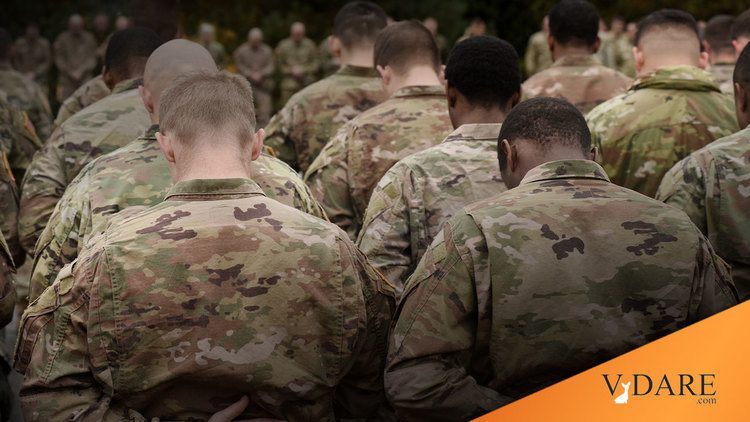
By Steve Sailer
01/25/2008
Fred Kaplan writes in Slate in Dumb and Dumber: The Army Lowers Recruitment Standards … Again:
The latest statistics — compiled by the Defense Department. and obtained through the Freedom of Information Act by the Boston-based National Priorities Project — are grim. They show that the percentage of new Army recruits with high-school diplomas has plunged from 94 percent in 2003 to 83.5 percent in 2005 to 70.7 percent in 2007. (The Pentagon’s longstanding goal is 90 percent.)The percentage of what the Army calls "high-quality" recruits — those who have high-school diplomas and who score in the upper 50th percentile on the Armed Forces' aptitude tests — has declined from 56.2 percent in 2005 to 44.6 percent in 2007.
In order to meet recruitment targets, the Army has even had to scour the bottom of the barrel. There used to be a regulation that no more than 2 percent of all recruits could be "Category IV" — defined as applicants who score in the 10th to 30th percentile on the aptitude tests. In 2004, just 0.6 percent of new soldiers scored so low. In 2005, as the Army had a hard time recruiting, the cap was raised to 4 percent. And in 2007, according to the new data, the Army exceeded even that limit — 4.1 percent of new recruits last year were Cat IVs.
The "aptitude" test is the Armed Forces Qualification Test (AFQT), which is a highly "g-loaded" functional equivalent of an IQ test. In fact, the military provided Charles Murray with all the AFQT data that makes up the middle section of The Bell Curve.
What’s interesting here is how much more the Army values IQ over a high school diploma — There are roughly as many high school dropouts (25% of all young adults according James Heckman) as there are people scoring at the 30th percentile or less on the military’s IQ test (30%, by definition). Yet, the military has only allowed the percentage of new recruits below the 30th percentile to increase from 0.6% to 4.1%. Yet, over roughly the same time period, it has allowed the percentage of high school dropouts it takes in to grow from 6% to 29.3%.
Second, and more practically, high-school dropouts tend to drop out of the military, too. The National Priorities Project cites Army studies finding that 80 percent of high-school graduates finish their first terms of enlistment in the Army — compared with only about half of those with a General Equivalency Degree or no diploma. In other words, taking in more dropouts is a short-sighted method of boosting recruitment numbers. The Army will just have to recruit even more young men and women in the next couple of years, because a lot of the ones they recruited last year will need to be replaced.Third, a dumber army is a weaker army. A study by the RAND Corporation, commissioned by the Pentagon and published in 2005, evaluated several factors that affect military performance — experience, training, aptitude, and so forth — and found that aptitude is key. This was true even of basic combat skills, such as shooting straight. Replacing a tank gunner who had scored Category IV with one who'd scored Category IIIA (in the 50th to 64th percentile) improved the chances of hitting a target by 34 percent.
Today’s Army, of course, is much more high-tech, from top to bottom. The problem is that when tasks get more technical, aptitude makes an even bigger difference. In one Army study cited by the RAND report, three-man teams from the Army’s active-duty signal battalions were told to make a communications system operational. Teams consisting of Category IIIA personnel had a 67 percent chance of succeeding. Teams with Category IIIB soldiers (who had ranked in the 31st to 49th percentile) had a 47 percent chance. Those with Category IVs had only a 29 percent chance. The study also showed that adding a high-scoring soldier to a three-man team increased its chance of success by 8 percent. (This also means that adding a low-scoring soldier to a team reduces its chance by a similar margin.)
In case you are wondering, here’s the Wikipedia summary of the AFQT (which is the crucial subset of the larger ASVAB — the AFQT determines whether you are allowed in, while the other parts of the ASVAB influence your specialty once you are in).
An Armed Forces Qualification Test (AFQT) score is used to determine basic qualification for enlistment.AFQT Scores are divided into the following categories:
- Category I — 93-99
- Category II- 65-92
- Category IIIA — 50-64
- Category IIIB — 31-49
- Category IVA — 21-30
- Category IVB — 16-20
- Category IVC — 10-15
- Category V — 0-9
The formula for computing this AFQT score is: Arithmetic Reasoning + Math Knowledge + (2 x VE). The VE (verbal) score is determined by adding the raw scores from the Paragraph Comprehension and Word Knowledge tests (i.e., how many questions the aspiring recruit got right on each) and using a table to get the VE score from that combined PC and WK raw score.
AFQT scores are not raw scores, but rather percentile scores indicating how each examinee performed compared with all other examinees. Thus, someone who receives an AFQT of 55 scored better than 55 percent of all other examinees.
Law prohibits applicants in Category V from enlisting. In addition, there are constraints placed on Category IV recruits. Presently, all Category IV recruits must be high school diploma graduates. Further, the law constrains the percentage of accessions who can fall in Category IV (currently, the limit is 20%).
This is a content archive of VDARE.com, which Letitia James forced off of the Internet using lawfare.